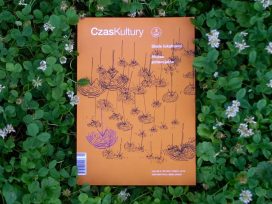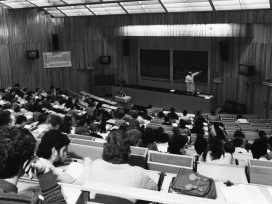Children of the twenty-first century
Youth, culturally associated with the future, seems increasingly afflicted by uncertainty and crises. Can looking ahead be informed by past moments of transition? In 1960s Poland young people’s ‘futurological’ outlooks uncovered the microsocial ambivalences of technological progress, revealing cracks in mass communist ideology.
‘Although the future belongs to the young, future thinking … is more the domain of older people,’ wrote Andrzej Siciński.1 The sociologist’s provocative statement follows the study he and a team of researchers conducted on young people’s visions of the future in Poland during the second half of the 1960s. The then 44-year-old researcher had become curious when he noticed that young people in 1960s Poland seemed increasingly interested in their own future, and that of their country and the world.
Youth in Poland in the 1960s
Being young in Poland during the 1960s meant coming of age in a highly ambivalent decade. In the history of the Polish People’s Republic, it is remembered, on the one hand, as a period of mała stabilizacja (small stabilization) with moderate yet constant rates of economic growth, mostly satisfying basic consumer needs, housing and healthcare. Many Poles aligned with the socialist political system, which was still governed by strict authoritarian state-control over social, cultural and economic life. The Communist party was demanding less ideological commitment from Poles than in previous decades, trying to win their support instead through strong nationalist rhetoric and a less aggressive stance towards the Catholic Church.
The decade was simultaneously a period of change for young Poles, in keeping with their peers in the East and the West.2 The World Festival of Youth and Students in Warsaw in 1955 had been a formative experience for a whole generation of Poles: around thirty-thousand foreigners, also from the West, were invited to their capital to encounter the qualities of communist life. But the festival also opened the eyes of Polish youth and is considered one of the catalysts of political change that led to the moderate opening of the repressive state socialist regime.3
Newly gained economic stability and a relatively peaceful international political environment led the socialist regime to a moderate cultural and scientific opening to the West. Television became a true mass medium. Sociologists noted the emergence of popular mass culture alongside new, diverse lifestyles. Young Poles, through the role models, leisure activities, fashion, tourist destinations, or consumer aspirations they revered and pursued, increasingly defined themselves in relation to global youth culture.4

Earth and Mars combined. Illustration by ultrasoftproduction via Wikimedia Commons.
Moreover, new scientific and technological developments such as computers, space travel and nuclear energy were expected to transform society via automatized and informatized production. From 1961 onwards the Soviet Union and its satellite states officially considered the so called ‘scientific-technical revolution’ the necessary precondition for furthering communism. The political regime’s highest echelons, who held the vision of this ‘one and only future’, tasked scientists and technological experts to develop scientific predictions and holistic approaches.5 In the second half of the 1960s, social scientists, journalists and writers engaged with what Siciński called a global ‘explosion of futurology’6 – in other words, controversies over new scientific tools of predictions and complex future-thinking, which experts and institutions in the US and western Europe had been developing since the early 1950s.
Imagining the year 2000
From 1967 to 1968, Siciński and his team at the Polish Academy of Sciences conducted a sociological survey on youngsters’ visions of the future. Their research started from an observation that young Poles were ‘discovering’ the future as a ‘new dimension of thinking’.7 With a questionnaire and a representative sample of nearly 1,000 respondents, the researchers tried to capture young Poles’ thoughts and predictions for the year 2000.8
When asked about their expectations for Poland’s social structure, 21% of the respondents said that they expected social disparities to increase, while 24% awaited their stagnation, and 41% their decrease. The desired outcome differed remarkably, however: 73% of young Poles hoped that social disparities would diminish by the year 2000. Only 8% hoped they would increase. While support for socialism’s major promise of equal distribution of social and economic resources appeared to have been strong, trust in the system’s ability to deliver seemed to be much lower. The overall vision of Poland 2000 was of a more urbanized, equal country with more women and young people in decision-making positions, a strongly automatized economy and a satisfied population.
Asked about their visions of the international situation in 2000, young Poles in 1968 were convinced that the divide between socialism and capitalism would still be the dominant line of conflict. Only 8% could imagine that such differences would vanish. 29% imagined a peaceful coexistence, while nearly half of the respondents either expected ‘serious tensions’ or military conflict.
The results suggest that young people in 1968 Poland had a vision of the future that was very much in line with official state propaganda. The questionnaires had been through political censorship, omitting sensitive topics, and it cannot be verified whether respondents feared consequences if answering one way or the other.
Future-thinking in 1968/9
The authors of the survey did not aim to predict what the year 2000 would look like. Their research had a diagnostic instead of a prognostic goal, which they explained as ‘learning more about how the future enters young people’s minds’.9 What shaped their future-thinking today, was what sociologists wanted to find out. The study was part of an international project comparing the attitudes of young people from ten different countries, spanning various political and geographical locations. The sociologists noticed a strong tendency to envision a common, global future. However, they rejected the widespread interpretation that conflict with older generations united all the political protests and clashes between young people and state forces that were sweeping the world in 1968, including those in Warsaw and Prague. In other words, the sociological study could be used to support a common narrative of ruling elites from the older generations, namely that only a minor, negligible fraction of ‘radicals’ was on the barricades.
However, the authors pointed towards another, arguably more fundamental subversion of the official communist ideology. They had used a macro-sociological approach which turned answers into numbers, comparing and correlating responses with each other and features such as class, nationality and gender. In combination with Marxist theory, they had expected socio-economic factors to explain differences in young peoples’ perceptions of the future. However, Siciński argued that the true determinants of young people’s visions remained undiscovered because the ‘microsocial’ had been left out of the picture.10 He suspected future-thinking to emerge from the social and psychological dynamics of small groups, informal networks, from individual voices and emotions. Intentionally or not, this conclusion questioned a fundamental premise of socialist and, more generally, twentieth century politics – namely that young people’s future-thinking was primarily shaped by state and collective practices channelled through mainstream political organizations or state-organized education. Besides, the researchers had shown that although everyone had been asked for their visions in 1968, 2000 was not equally close nor distant to everyone. The ship of socialist society was no longer progressing at a single steady pace through historical time towards the dock of a communist future.
Pipelines into the future
Nevertheless, the sociologists’ hope in 1968 was that mass media, education and scholarly works, such as theirs, would lead the young to think of the future even more often. And they were not alone in observing and trying to influence the discovery of the future by young Poles. In 1969 the weekly publication Perspektywy (Perspectives) was established to cover a wide range of topics from international politics to social and cultural affairs, sports and technological developments. Its goal was also to shape readers’ perspectives on the future – to make them think ‘futurologically’. In the first issue in September 1969, the editor-in-chief argued that young Poles were indeed ‘Children of the Third Millennium’, who should be guided by ‘rational’ and scientific future-thinking in preparation for their adult responsibility for socialist Poland.11 For two years the magazine devoted a weekly two-page essay with ‘perspectives on the twenty-first century’ to this programmatic goal. In retrospect, it provides an interesting window on the visions which shaped how young people in Poland imagined the next century at the turn of the 1960s and 1970s.
These essays discussed ground-breaking technological and scientific developments and their social consequences, questioning whether and when they would become possible. Answers were loaded with optimism. For instance, humans settling on the moon in the first half of the twenty-first century was presented as highly possible. It was thought that technological progress combined with social scientific expertise would have far-reaching, positive impacts on everyday life, economic behaviour, nature and international politics – and prevent undesirable outcomes.
However, readers were not expected to have blind faith in technological solutions for social problems. On the contrary, the authors, who were renowned scientists and journalists from Poland, rejected ‘passive acceptance’ of new technologies, encouraging the ‘realization of individual mental and physical interests’ instead.12 Usually, they presented the future as an open question, describing – not without signs of humour – various positive and negative scenarios. Presenting scientific and technological progress as ambivalent and calling for its submission to individual and social creativity, implicitly challenged the idea that more advanced technology would lead straight towards the victory of communism.
Nevertheless, trust in techno-utopian feasibility prevailed in most essays. Writers trusted that the scientific and planned development of socialism would be the best guarantee for a ‘humanistic’ use of technology not driven by commercial benefits. They heralded computers as ‘the brains of humankind’ that would not only take more ‘rational’ economic decisions but also make government less bureaucratic and more transparent and democratic. Finally, the essays conveyed a strong sense that historical progress could be guided by scientific and technological reason and respective political action. The underlying notion of the present and the future being connected by a more or less continuous line of progression is displayed, for example, by the title of an essay, which discussed the prospects and issues with constructing submarine tunnels between different continents for long-distance train travel: the tunnels were described as ‘pipelines running into the future’.13
However, those pipelines did not exist yet. In other words, the future was rather distant and disconnected than easy to grasp. To finish its biannual series of essays on the twenty-first century, the weekly organized an expert survey among 20 prominent Polish scientists. Adapting the Delphi technique, a method for gathering expert knowledge developed by a US Think Tank in the early 1950s, the editors asked them questions like: when did they expect the first human to land on Mars; if and when would socialism supersede market-based capitalist systems; when would humans be capable of preventing natural events such as earthquakes and hurricanes. Although the organizers of the survey wrote that it was more of a ‘futurological game’, they trusted that it would nevertheless contain ‘important findings for tomorrow’.14 According to the collected Polish expert opinions, 2050 was the date by which both humans would travel to Mars, and socialism would have proven superior to capitalism in efficiently delivering social and economic prosperity. Control over earthquakes and extreme weather events was anticipated even sooner, to be already mastered by the year 2000.
History of the future
Even if, in retrospect, the predictions of young Poles from the late 1960s for the year 2000 seem flawed, they may have played an important role at the time in shaping world views, social communication and political action. Both the outlined sociological study and weekly publication capture elements and limitations of historical ‘horizons of expectation’, which are relevant to more than historians. 15
Looking at past futures can equip us with greater awareness for the origins of today’s future-thinking. Whether Polish sociologists’ discovery of the microsocial roots of future-thinking already pointed towards a more fundamental transformation of modern industrial societies, whose collective solidarities gave way to more flexible, particularistic orientations, visible in today’s social media and informational bubbles, would require further inquiry. As the course of history evolves, one sometimes forgets that the past had many possible imagined futures, including the ones considered by young Poles in their engagement with sociological research or futurological ‘perspectives’.
Investigating the ‘children of the twenty-first century’ of the 1960s raises questions about today’s future-thinking: how are visions of the future constructed; how do they gain credibility; which emotions and actions do they encourage or dissuade; which political agendas are they related to, and whose visions are they. ‘Futures literacy’, propagated as an important competence in current times of social and environmental transformation, would encompass a critical historical consciousness of the future’s multiple pasts.16
This article has been published as part of the youth project Vom Wissen der Jungen. Wissenschaftskommunikation mit jungen Erwachsenen in Kriegszeiten, funded by the City of Vienna, Cultural Affairs.
A. Siciński, Młodzi o roku 2000. Opinie, wyobrażenia, postawy, Instytut Wydawniczy CRZZ, 1975, p. 139.
M. Zaremba, ‘Społeczeństwo polskie lat sześćdziesiątych – między „małą stabilizacją” a „małą destabilizacją”’, in Oblicza Marca 1968, eds. K. Rokicki and S. Stępień, IPN, 2004, pp. 24-51.
W. Borodziej, Geschichte Polens im 20. Jahrhundert, C.H Beck, 2010, pp. 295-96; A.L. Sowa, Historia polityczna Polski 1944-1991, Wydawnictwo Literackie, 2011, pp. 206-7.
M. Fidelis, Imagining the World from Behind the Iron Curtain: Youth and the Global Sixties in Poland, Oxford University Press, 2022.
S. Guth‚ One Future Only: The Soviet Union in the age of the scientific-technical revolution’ in Journal of Modern European History, 3:13, 2015, pp. 355-376.
A. Siciński, Prognozy a nauka, Książka i Wiedza, 1969, p. 5.
A. Siciński, Młodzi o roku 2000. Opinie, wyobrażenia, postawy, Instytut Wydawniczy CRZZ, 1975, p. 29.
‘Young’, defined as coming of age and finding one’s place in society, included respondents between the ages of fifteen and forty.
J. Galtung, ‘On the future, future studies and future attitudes’ in Images of the world in the year 2000. A comparative ten nation study, ed.s H. Ornauer et al., Mouton, 1976, pp. 3-21, p. 7. The countries included in this study were Poland and Czechoslovakia, Yugoslavia, Finland, Great Britain, Norway, West Germany, the Netherlands, Spain, Japan, and India.
A. Siciński, Młodzi o roku 2000. Opinie, wyobrażenia, postawy, p. 112.
Dobrosław Kobielski (1969): Dzieci trzeciego tysiąclecia, in: Perspektywy 1, 5 September 1969, p. 4.
Ryszard Doński (ed.) (1971): Perspektywy XXI wieku. Szkice futurologiczne, Warszawa: Książka i Wiedza, p. 140-41.
L. Znicz, ‘Rura biegnąca w przyszłość’, Perspektywy, 14, 13 April 1970, pp. 39-40.
W. Błachowicz and J. Surdykowski, ’Ankieta futurologiczna, cz. I’, Perspektywy, 50, 17 December 1971, pp. 39-40; W. Błachowicz and J. Surdykowski, ’Ankieta futurologiczna, cz. II’, Perspektywy, 51, 24 December 1971, pp. 39-40.
R. Koselleck, ‘"Erfahrungsraum" und "Erwartungshorizont" - zwei historische Kategorien‘, Vergangene Zukunft. Zur Semantik geschichtlicher Zeiten, Suhrkamp, 1979, pp. 340-375.
'Futures literacy’ is prominently used by futures researchers, activists and policy-makers today, and defined by UNESCO as ‘the skill that allows people to better understand the role of the future in what they see and do. Being futures literate empowers the imagination, enhances our ability to prepare, recover and invent as changes occur.’ https://www.unesco.org/en/futures-literacy/about (last accessed 10 November 2023).
Published 1 December 2023
Original in English
First published by Eurozine
Contributed by RECET © Lukas Becht / RECET / Eurozine
PDF/PRINTIn collaboration with
In focal points
Newsletter
Subscribe to know what’s worth thinking about.
Related Articles

Neganthropology
Czas Kultury 2/2024
The politics and psychology of locality: on reviving local communities as high-tech expands and diversifies; forming networks against entropy; the Tortoise Strategy for caring; and rewriting life scripts.

The crux of different peoples’ history, and of humanity as a whole, is always food and hunger. In the final analysis, it’s the stomach that counts.






